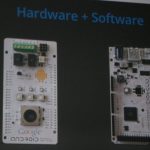The history of home automation from the beginning

That's a broad topic for a headline, and one that could fill a book. It dates back much further than people think. Thanks to today's modern technology and graphics, we don't need to write that book. It's all laid out before us in a nice infographic that shows the highlights of what you need to know about how we arrived at things like Harmony, Nest, Philips Hue and more.
The concept of home automation has been around for a long time but the technology just wasn't there. Many science-fiction writers included it in stories, Ray Bradbury famously among them.
Logitech Harmony remote gains new home automation integration

If you haven't used a Harmony remote then you're missing out. The device can control almost any object in your home theater. Lately it's been adding more home automation features as well, and the latest update enhances that aspect of the universal remote.
"We’re proud to celebrate the continued expansion of our smart home compatibilities with the integration of four great new partners into the Harmony ecosystem, and we hope you’re excited about the new possibilities coming your way. Now, homes with Harmony can control even more devices and create brand new Activities combining smart home devices in unique ways", Logitech announces.
Nitro Pro 10 arrives, gains batch automation tool, PDF Portfolio creation

More than 18 months since its last major release, Nitro has launched a major new version of its award-winning 'Acrobat alternative' tool for creating, editing and converting PDFs, Nitro Pro 10.0.
Version 10 introduces a new Batch Processing tool for repetitive tasks, plus adds drag-and-drop support for creating PDFs and copying pages between documents. It also adds PDF Portfolio creation, PDF/A conversion, and wider support for various cloud-based storage services.
BetaNews exclusive: Home automation beta test opportunity from Betabound by Centercode

Home automation and the "Internet of Things" are the next frontiers for the technology world. Now that Wi-Fi is ubiquitous, the landscape is set for smart homes more than ever before. What used to seem like science fiction has become a reality. You can now turn on lights with products like Belkin's WeMo switch or monitor your pets with a Dropcam Pro camera. Heck, with products like the Nest thermometer, your home can actually learn from your behaviors.
Today, Betabound by Centercode is offering BetaNews readers an exclusive opportunity to apply for a beta test of an exciting new smart home system. Will you be selected?
Nest grows its home automation integration, Dropcam now in use

Home automation and the Internet of Things have become popular topics today. Users either love it or fear it, the latter thanks to very real security problems which have been discovered. Nest is no stranger to problems, thanks to its Protect issue from not long ago, but that hasn't stopped the company from moving forward, adding further integration.
The latest move is to partner with more home automation products in an effort to make everything play nicely together. The company, known for its smart thermostat, has joined forces with Whirlpool, Jawbone and LIFX under a program it calls "Works with Nest". It has also been working with home automation makers to get better integration.
Top business and IT process automation trends for 2014

Enterprise technology as we know it is changing. Several years ago, significant improvements in IT were viewed by the business as "nice to have" but not essential. Today many companies use their IT enterprise to deliver differentiated customer service, business intelligence (BI) and a more efficient supply chain. Still, some organizations lag behind. In fact, many businesses continue to rely on a loose federation of siloed applications and disconnected manual tasks to support their most critical operations.
Smart businesses recognize the short-sightedness of this outdated approach. These companies view IT infrastructure as a source of important competitive advantage core to business development. They use their enterprise to maintain -- and enhance -- their market position. Today IT success is business success. They are inevitably connected.
FastKeys is an ultra-versatile PC automation tool

When writing about new programs we’ll normally start with a general outline of what they do, but FastKeys ($9.99) makes that unusually difficult. It’s a highly versatile Windows automation program with support for several time-saving technologies, but how these are used is very much up to you.
The program could be a simple Start Menu replacement, for instance; move your mouse to the top edge of the screen and a basic Start menu appears. This starts off with just a few links (Office, system applets, Documents folder, a few web shortcuts, shutdown options), but can easily be expanded to add more.
ImBatch 2 adds even more image processing automation

High Motion Software has announced the release of ImBatch 2.0, its comprehensive image batch processing tool.
As before, you can use the program to resize or rotate photos, tweak colors and contrast, apply effects, set tags and more. But now you’re also able to apply new "AutoEnhance" tasks, which do their best to automatically optimize your target images.
The new Industrial Revolution -- the business impact of smart machines and automation

Analysts and journalists periodically voice concerns over smart machines stealing middle-class jobs. According to Kenneth Brant, research director at Gartner, "Most business and thought leaders underestimate the potential of smart machines to take over millions of middle-class jobs in the coming decades".
This is quite an assumption to make. Machines have been tools for efficiency for centuries now. They’re not as terrifying as some might think. The results have actually been quite the contrary. Rather than leaving workers on the streets, using "smart machines" to automate repetitive, manual tasks has allowed people to progress to more skilled labor, work fewer hours, and experience greater job satisfaction overall. It makes employees more strategic and empowered. And the story continues. Now, as computers grow ever faster and more powerful, we’re on the edge of another Industrial Revolution -- not on the factory floor -- but in the back office of business.
New app uses social collaboration to identify projects for automation

Business automation specialist Automation Anywhere has launched a new application aimed at helping businesses identify tasks and prioritize them based on the crowd-sourced wisdom of their user community.
Called Cumulus (could this possibly be using the cloud?) the application is launching via the Yammer enterprise social network. It will be available as a featured application via Yammer's app directory. Using Cumulus, anyone in an organization will be able to suggest a task to be automated, vote on the tasks that seem most valuable, contribute suggestions to existing initiatives, and track any active automation projects.
The rise of the Chief Automation Officer

In 1986, when BusinessWeek introduced "Management’s Newest Star," inviting us to "Meet the Chief Information Officer," the idea of adding anyone else to the C-Suite was not only revolutionary, it was frightening. Business computing was still a burgeoning field. Typewriters and paper files were the status quo. A CIO wasn’t just a new officer: a CIO was a new way of doing things -- everything.
And yet, less than 30 years later, it feels as if the CIO role has always been there: making decisions on key hardware and software purchases, working with his business-side counterparts to determine how to align software and strategy, monitoring new trends and technologies to determine which are worth implementing and which should be ignored. It’s hard to imagine any mid- to large-sized businesses without a CIO on board.
Google extends Android into embedded hardware, home automation

At the Android Keynote on the first day of Google I/O 2011, Google announced the next version of Android called Ice Cream Sandwich will unify tablets, phones, and Google TV devices under a single version of the operating system. Yet a new facet to Android was introduced today that may turn out to be the most left-field announcement of the conference: Android for embedded devices and home automation.
Android founder Andy Rubin summed up the operating system's progress in the following way at a press conference Tuesday morning: Android started with phones, then grew to tablets, and now it should grow to everything.
Recent Headlines
Most Commented Stories
BetaNews, your source for breaking tech news, reviews, and in-depth reporting since 1998.
© 1998-2025 BetaNews, Inc. All Rights Reserved. About Us - Privacy Policy - Cookie Policy - Sitemap.